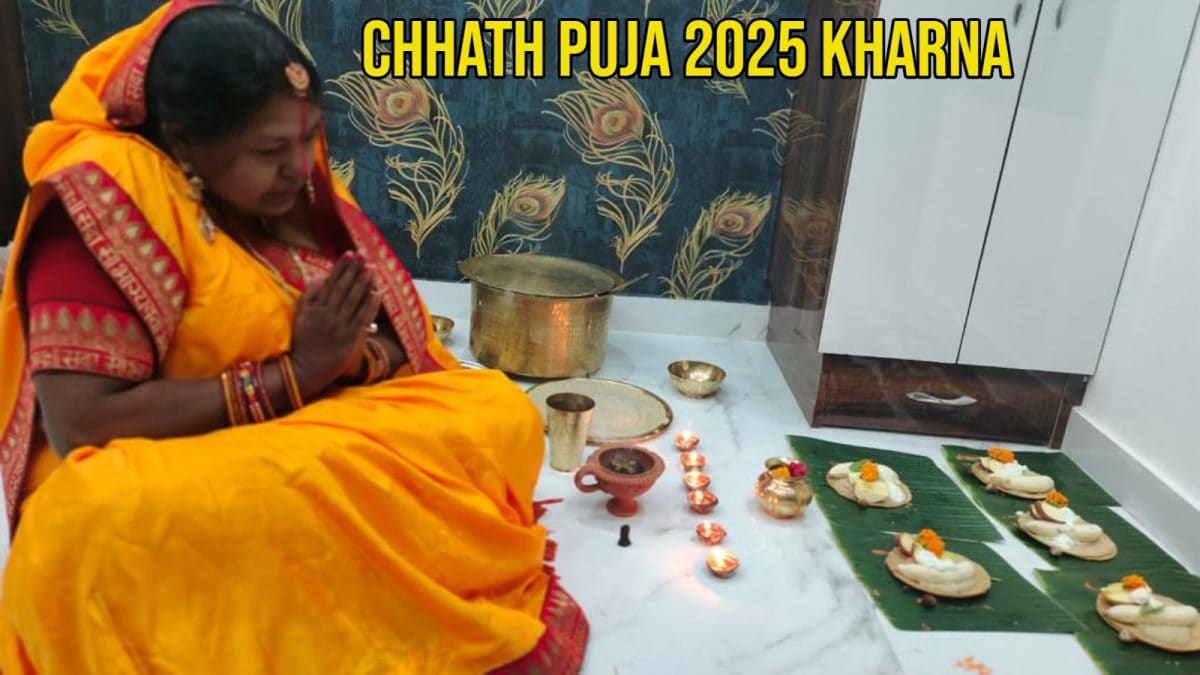Last Updated:
Chhath Puja 2025 Kharna Vidhi: Kharna marks the start of a sacred fast honouring Lord Surya. Learn the rituals, fasting rules, and Prasad traditions that embody purity and devotion
Chhath Puja 2025: The second day of the festival, called Kharna, is one of the most important parts of Chhath Puja. (Image: Shutterstock)
Chhath Puja 2025 Kharna Vidhi: Chhath Puja is one of the most sacred and ancient Hindu festivals dedicated to Lord Surya, the Sun God and Chhathi Maiya. This festival expresses gratitude to the Sun for sustaining life on Earth and symbolises purity, devotion and discipline. The four-day celebration in 2025 will be observed from October 25 to October 28, with the main Chhath Puja falling on October 27.
Chhath Puja 2025: Sunrise, Sunset Time On October 27
- Sunrise on Chhath Puja Day – 06:30 AM
- Sunset on Chhath Puja Day – 05:40 PM
- Shashthi Tithi Begins – 06:04 AM on Oct 27, 2025
- Shashthi Tithi Ends – 07:59 AM on Oct 28, 2025
Chhath Puja 2025 Puja Vidhi
The rituals of Chhath Puja are performed over four consecutive days, each having its own spiritual significance and set of practices devoted to worshipping the Sun God.
The first day, known as Nahay Khay, marks the beginning of the festival.
On this day, devotees take a holy dip in a river or sacred water body, most commonly the Ganga, to purify their body and soul. After bathing, the women who observe the fast, known as Vratis, eat only a single meal prepared from pure and simple ingredients, free from onion, garlic or salt. This meal signifies the start of a disciplined and devotional period.
The second day, called Kharna, is one of the most important parts of Chhath Puja.
Devotees observe a strict fast without consuming food or water from sunrise to sunset. After sunset, they prepare special offerings for Lord Surya, which include gur ki kheer (sweet rice pudding made with jaggery), puris and fruits.
ALSO READ: Chhath Puja 2025 Date: Sunset And Sunrise Timing
These offerings, known as Prasad, are first presented to the Sun God and then shared among family members and friends. After completing the evening prayers, the Vratis break their fast. From this point, they begin a 36-hour-long fast without even a sip of water, which continues until the next sunrise after the final rituals.
The third day of the festival is the most significant and known for offering Sandhya Arghya, the evening worship of the setting Sun.
Devotees gather at riverbanks, ponds or ghats, carrying baskets filled with fruits, sugarcane and thekua (a traditional sweet). As the sun sets, they offer Arghya — a mixture of water, milk and flowers, to the setting Sun as an expression of gratitude for life, health and prosperity.
Devotees continue their fast through the night, spending time in prayer and devotional songs dedicated to Lord Surya and Chhathi Maiya.
The festival concludes with the Usha Arghya, the morning offering to the rising Sun, performed on the fourth and final day.
Devotees gather before dawn to witness the sunrise and offer prayers to Lord Surya, seeking blessings for the happiness and well-being of their families. After offering Usha Arghya, they end their 36-hour-long fast, an act known as Parana. The Prasad prepared during the rituals is then distributed among family, friends, and neighbours as a symbol of love, harmony and gratitude.
Chhath Puja Fasting Rules
The fasting rituals of Chhath Puja are known for their intensity and spiritual depth. The fast observed during Kharna represents purity, restraint and unwavering devotion.
Devotees maintain absolute cleanliness in their homes and surroundings, as purity is considered essential during the four-day observance.
- On the first day, devotees consume only one meal after performing prayers to Lord Surya.
- The second day involves a complete fast without food or water, which is broken only after sunset.
- Once Kharna is completed, devotees begin a 36-hour-long fast without food or water until the morning of Usha Arghya.
Preparation of Prasad
The preparation of Prasad holds a sacred place in Chhath Puja, especially during Kharna. The offerings symbolise devotion, simplicity and gratitude toward Lord Surya.
The most important Prasad is kheer, a sweet rice pudding made from jaggery, rice and milk. It is traditionally cooked on a clay stove or chulha, using mango wood, which is believed to purify the offering and enhance its sanctity.
The Prasad is served on fresh banana leaves and accompanied by roti and bananas. The cooking process is carried out in a serene environment, with complete silence and purity.
The Vrati, or devotee, prepares the Prasad with utmost devotion, refraining from any distraction. After the offering is made to Lord Surya, the Prasad is consumed by the devotee in peace, symbolising spiritual fulfilment and the beginning of the next stage of fasting.
Our life needs a bit of style to get the perfect zing in the daily routine. News18 Lifestyle is one-stop destination for everything you need to know about the world of fashion, food, health, travel, relationshi…Read More
Our life needs a bit of style to get the perfect zing in the daily routine. News18 Lifestyle is one-stop destination for everything you need to know about the world of fashion, food, health, travel, relationshi… Read More
October 26, 2025, 06:05 IST





